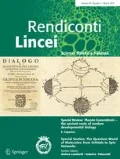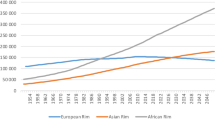Abstract
The Mediterranean Sea was once an element of wealth and cultural and economic exchange, while today it has become an element of closure, a natural border, especially to people migrations. Considering the macro processes in action, we consider that the whole region should have the chance to flourish again. The global demographic centre of gravity is moving southward, with African population that will double from the current one billion to two billion by 2050. In the Mediterranean basin, the old demographic ratios are bound to reverse in favour of Northern Africa countries, which will double in number the European shore. Along with the population, also the global workforce is expected to explode: in Africa alone it will be necessary to create about 725 million new jobs in the next 40 years to absorb the additional labour supply due to demographic factors. This will create a huge migration pressure towards Europe. Also the economic centre of gravity shifts southward. Production is moving where work is more available and cheaper, thus emerging countries attract investment and in perspective will generate two-thirds of global GDP growth. Together with international competition, technological change may put further pressure over world labour markets. These processes will need a renewed global governance. The paper proposes a shift toward a regionalized global governance, and the institution of a Mediterranean Union of 54 countries, able to provide both shores of the sea a significant role in the international arena and foster their economic development.




Similar content being viewed by others
References
Brynjolfsson E, McAfee A (2011) Race against the machine: how the digital revolution is accelerating innovation, driving productivity, and irreversibly transforming employment and the economy. Digital Frontier Press, USA
Frey CB, Osborne MA (2013) The future of employment: how susceptible are jobs to computerisation?. University of Oxford, Oxford Martin School
Golini A (2007) Tendenze demografiche e implicazioni socio-economiche, 18.01.07
Golini A, Di Bartolomeo A (2009) The impact of massive migration flow on regional population structure: the case of Italy. In: Vienna Yearbook of population research. pp 149–165
Levinson M (2006) The box: how the shipping container made the world smaller and the world economy bigger, Princeton University Press
McKinsey Global Institute (2012) Manufacturing the future: the next era of global growth and innovation. McKinsey & company, New York
McKinsey Global Institute (2013) Disruptive technologies: advances that will transform life, business, and the global economy. McKinsey & company, New York
Quadro Curzio A (2014) Il rilancio del Sud passa (anche) dall’Europa. Il sole ore 24
Rifkin J (1995) The End of Work. Tarcher/Putnam
Author information
Authors and Affiliations
Corresponding author
Additional information
This contribution is the extended, peer reviewed version of a paper presented at the conference “Sustainable management of the Mediterranean” held at Accademia Nazionale dei Lincei in Rome on March 21, 2014.
Rights and permissions
About this article
Cite this article
Golini, A., Grimaccia, E. & Rondinella, T. Demographic, economic and geopolitical issues of the Mediterranean area. Rend. Fis. Acc. Lincei 26, 81–86 (2015). https://doi.org/10.1007/s12210-014-0326-9
Received:
Accepted:
Published:
Issue Date:
DOI: https://doi.org/10.1007/s12210-014-0326-9




